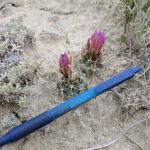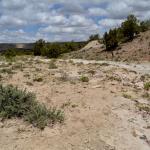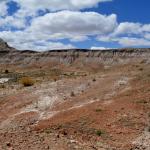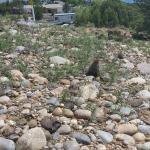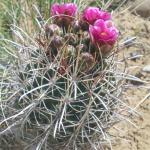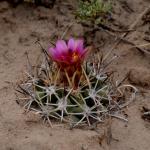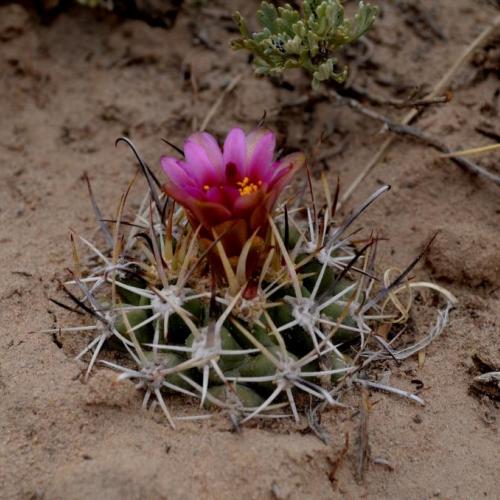Sclerocactus cloverae (Clover's cactus)
Sclerocactus cloverae ssp. brackii K.D. Heil & J.M. Porter; Sclerocactus cloverae ssp. cloverae K.D. Heil & J.M. Porter; Sclerocactus coveriae ssp. cloveriae K.D. Heil & J.M. Porter; Sclerocactus cloveriae ssp. brackii K.D. Heil & J.M. Porter; Sclerocactus cloveriae K.D. Heil & J.M. Porter; Sclerocactus whipplei (Engelmann & J. M. Bigelow) Britton & Rose var. heilii Castetter, P. Pierce & K. H. Schwerin; Sclerocactus whipplei var. reevesii Castetter, P. Pierce & K.H. Schwerin; Pediocactus cloverae (K. D. Heil & J. M. Porter) Halda
| USFWS | State of NM | USFS | BLM | Navajo Nation | State Rank | Global Rank | R-E-D Code | NMRPTC Status | Strategy Status |
|---|---|---|---|---|---|---|---|---|---|
| E | SEN | GP 3 | S3 | G3 | R | SS |
| Overall Conservation Status | Documented Threats | Actions Needed |
|---|---|---|
| UNDER CONSERVED | Oil & gas development, insect and rabbit herbivory, wood cutting, grazing impacts, OHV traffic. |
Population trend monitoring, threat impact monitoring (dust, transplanting, rodents & rabbits, drought, oil & gas development), seed banking. |
Stems unbranched (occasionally 2-3-branched near base), green, ovoid to elongate-cylindric, 2.9-25(-35) × 2.8-12.5(-20) cm; ribs usually (11-)13(-15), well developed, tubercles evident on ribs. Spines obscuring stems; radial spines 4-6 per areole, acicular, elliptic or rhombic in cross section, 19 × 1.3-2 mm; central spines 6-9 per areole, usually 8; abaxial central spine usually 1 per areole, porrect, straw colored to brown, highlighted with purple or red, terete or somewhat angled, hooked, (15-)30-46 × 1.5 mm; lateral central spines 5-8 per areole, similar to abaxial but slightly shorter and usually not hooked; adaxial central erect, white or straw colored, straight or curved, angled to flat, somewhat inconspicuous, triangular in cross section, 25-55 × 1-2 mm. Flowers narrowly funnelform to campanulate, 2.5-3.5(-4) × 1.6-3.1(-3.6) cm; outer tepals with greenish to purple with brownish midstripes, pink, purple, or whitish margins, larger ones oblanceolate, 10-18 × 4-7.5 mm, margins membranous and crisped or minutely toothed, apex mucronate; inner tepals purple, sometimes suffused with brown, largest tepals oblanceolate, 15-22(-30) × 4-6 mm, margins irregularly toothed, apex mucronate; filaments white, tinged with pink to pink-purple; anthers yellow; ovary minutely papillate, appearing smooth. Fruits irregularly dehiscent or dehiscent through basal abscission pore, green to tan, sometimes suffused with pink, 7-15 × 5-12 mm, dry; scales few, membranous, scarious-margined, minutely toothed or fringed. Seeds brown or black, 1.2-2.5 × 1.9-3.5 mm; testa with rounded papillae. (Flora of North America, Vol. 4, 2003).
Flowering late April to early June
Sclerocactus cloverae is similar in appearance to Sclerocactus parviflorus but has more dense spines and smaller purple flowers. S. cloverae flowers: 2.5-3.5(-4) × 1.6-3.1(-3.6) cm; radial spines: 4- 6 per areole; S. parviflorus: flowers:(2-)3-5.7(-7) × 2.5-5.5(-8) cm; radial spines: 8 - 17 per areole
New Mexico: San Juan, Sandoval, and Rio Arriba counties. Colorado: La Plata County
Sandy clay strata of the Nacimiento Formation in sparse shadscale scrub; sandy, gravelly, or clay hills, mesas, and washes, desert grasslands, saltbush, sagebrush, and rabbitbrush flats, pinyon-juniper woodlands; 1,500 - 2,200 m (4,921 - 7,217 ft).
A genetic analysis in 2018 found that subspecies brackii was not genetically distinct from subspecies cloverae (Porter & Clifford 2018). Hence the two subspecies were combined into S. cloverae.
The same analysis found that Clover’s cactus (both former subspecies combined) displays a high degree of genetic
differentiation across its range and populations in the southern portion of its range should be considered a distinct genetic element.
Oil and gas development is the most significant current and active threat to most populations of the species, and especially to the largest population, which occurs in the vicinity of Lybrook (Muldavin et al. 2016). The majority of known occupied sites and habitat occurs within areas of active oil and gas leases on BLM lands (80%). Additional threats include insect and rodent/rabbit herbivory, OHV traffic, grazing impacts, wood cutting, and climate change.
*Heil, K.D. and J.M. Porter. 1994. Sclerocactus (Cactaceae) a revision. Haseltonia 2:20-46.
Flora of North America Editorial Committee. 2003. Flora of North America, Volume 4. Oxford University Press, New York.
Muldavin, E., R. Sivinski, M. East, Y. Chauvin, and Mark Horner. 2016. Brack's hardwall cactus distribution, habitat, aMuldavinnd status survey 2015. Unpublished report prepared for the BLM State Office, Santa Fe, NM by Natural Heritage New Mexico, Museum of Southwestern Biology and Department of Biology, University of New Mexico, Albuquerque, NM. 61 pp.
[https://nhnm.unm.edu/sites/default/files/nonsensitive/publications//NHNM_BracksCactus2015SurveyReport_Final20160506.pdf]
Porter, M.J. and A. Clifford. 2018. Genetic diversity within Sclerocactus cloverae Heil & Porter based on ddRAD-seq: the genetic basis for subspecies recognition. Final report to the BLM New Mexico State Office, Santa Fe, NM.
For distribution maps and more information, visit Natural Heritage New Mexico

